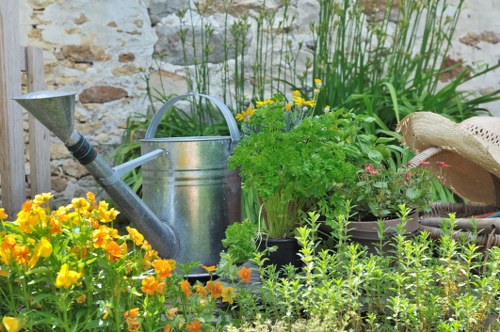House Cleaning in Kitchen Cleaning

Introduction to Kitchen Cleaning
The kitchen is often regarded as the heart of the home, where families gather to prepare meals and spend quality time together. Maintaining a clean kitchen is essential not only for aesthetic reasons but also for health and safety. A well-kept kitchen can prevent the spread of bacteria, reduce the risk of accidents, and create a pleasant environment for cooking and socializing.
Effective kitchen cleaning involves more than just wiping down surfaces. It requires a systematic approach to tackle various areas, from countertops and appliances to floors and cabinets. Understanding the best practices and techniques for kitchen cleaning can make the task more manageable and efficient.
In this comprehensive guide, we will explore the essential steps and tips for achieving a spotless kitchen. Whether you're a busy professional, a parent juggling household responsibilities, or someone who loves a clean space, this article will provide valuable insights to keep your kitchen in pristine condition.

Essential Kitchen Cleaning Tools and Supplies
Having the right tools and supplies is crucial for effective kitchen cleaning. Investing in quality cleaning products can save time and effort while ensuring thorough sanitation. Here are some must-have items for your kitchen cleaning arsenal:
- All-Purpose Cleaner: Suitable for cleaning a variety of surfaces, including countertops, appliances, and cabinets.
- Disinfectant: Essential for killing germs and bacteria, especially in areas prone to contamination.
- Microfiber Cloths: Ideal for wiping surfaces without leaving streaks or lint.
- Scrub Brushes: Effective for tackling tough stains and grime in sinks, stovetops, and ovens.
- Dish Soap: Necessary for cleaning dishes, utensils, and even certain surfaces.
- Baking Soda and Vinegar: Natural cleaning agents that are safe and environmentally friendly.
- Gloves: Protect your hands from harsh chemicals and hot water during cleaning.
Having these tools on hand will make your kitchen cleaning routine more efficient and ensure that every corner of your kitchen is thoroughly cleaned.
Additionally, consider organizing your cleaning supplies in a dedicated caddy or cabinet to keep them easily accessible. This organization can streamline your cleaning process and help you maintain consistency in your kitchen maintenance.

Step-by-Step Kitchen Cleaning Guide
1. Declutter and Organize
Before you begin cleaning, remove any clutter from countertops, tables, and other surfaces. Organize items into categories, such as utensils, appliances, and cooking ingredients. Discard any expired or unused items to create more space and make the cleaning process smoother.
Sorting and Disposal
Sort your items into keep, donate, and discard piles. Proper disposal of garbage and recyclables is also essential to maintain a hygienic kitchen environment.
Organizing Storage Areas
Arrange your storage areas, including cabinets and drawers, to maximize space and accessibility. Use organizers, trays, and containers to keep similar items together and prevent clutter from accumulating.
2. Clean Countertops and Surfaces
Start by wiping down all countertops and surfaces with an appropriate cleaner. Pay special attention to areas around the stove, sink, and any high-touch zones.
Removing Stains and Spills
Use a scrub brush or sponge to remove stubborn stains and spills. For persistent grime, a mixture of baking soda and water can be effective.
Sanitizing Surfaces
After cleaning, apply a disinfectant to sanitize surfaces and eliminate any remaining bacteria. Allow the disinfectant to dry completely before placing items back on the countertops.
3. Clean Appliances
Appliances can harbor grease, food particles, and bacteria. Regular cleaning extends their lifespan and ensures they function efficiently.
Refrigerator Cleaning
Empty the refrigerator and discard any expired or spoiled food items. Wipe down shelves and drawers with a mild cleaner. Organize items to promote better airflow and prevent cross-contamination.
Stovetop and Oven Maintenance
Remove burners and knobs, soaking them in warm, soapy water. Clean the stovetop with a suitable cleaner, and use an oven cleaner for the interior, following the manufacturer's instructions for safety.

Deep Cleaning Tips for Specific Areas
1. Sink and Faucet
The sink and faucet are high-usage areas that require regular cleaning to prevent buildup and odors.
Removing Buildup
Use a mixture of baking soda and vinegar to descale the faucet and remove mineral deposits. Scrub the sink with a non-abrasive cleaner to eliminate stains and grime.
Disinfecting Techniques
After cleaning, rinse the sink thoroughly and apply a disinfectant to sanitize the area. Ensure that all surfaces are dry to prevent the growth of mold and mildew.
2. Cabinets and Drawers
Cabinets and drawers can accumulate dust, grease, and food particles over time.
Wiping Down Surfaces
Use a damp cloth with mild soap to wipe down cabinet doors and drawer fronts. Pay attention to edges and corners where dirt can accumulate.
Organizing Contents
Take the opportunity to reorganize the contents of your cabinets and drawers. Group similar items together and use organizers to maintain order and accessibility.
3. Floors
Kitchen floors are prone to spills, stains, and debris, requiring regular cleaning to maintain hygiene.
Sweeping and Mopping
Sweep the floor to remove loose dirt and debris. Follow up with mopping using a suitable floor cleaner, paying attention to corners and under appliances.
Dealing with Stubborn Stains
For stubborn stains, apply a mixture of vinegar and water or use a commercial stain remover. Scrub gently to lift the stain without damaging the flooring material.

Maintenance Tips for a Long-Lasting Clean Kitchen
1. Implement a Regular Cleaning Schedule
Consistency is key to maintaining a clean kitchen. Establish a daily, weekly, and monthly cleaning routine to ensure that all areas are addressed regularly.
Daily Cleaning Tasks
- Wipe down countertops and stovetop after each use.
- Wash dishes or load them into the dishwasher.
- Sweep the floor to remove crumbs and debris.
Weekly and Monthly Tasks
- Deep clean appliances and cabinets.
- Mop the floors and sanitize surfaces.
- Declutter and reorganize storage areas.
2. Adopt Smart Storage Solutions
Efficient storage can reduce clutter and make cleaning easier. Use shelves, racks, and containers to keep items organized and accessible.
Utilizing Vertical Space
Install shelves or hanging racks to maximize vertical space and free up countertop and cabinet areas.
Investing in Quality Organizers
Quality organizers, such as drawer dividers and cabinet inserts, can help maintain order and prevent items from becoming disorganized over time.
3. Practice Good Kitchen Hygiene
Maintaining cleanliness goes beyond visible surfaces. Incorporate good hygiene practices to ensure a healthy kitchen environment.
Safe Food Handling
Always store food properly, separate raw and cooked items, and use airtight containers to prevent contamination and spoilage.
Regularly Emptying Trash and Recycling
Empty trash and recycling bins frequently to avoid unpleasant odors and attract pests. Clean the bins periodically to maintain hygiene.
4. Use Natural Cleaning Solutions
Natural cleaning solutions are effective, safe, and environmentally friendly alternatives to commercial products.
Baking Soda and Vinegar
A versatile duo, baking soda and vinegar can tackle a wide range of cleaning tasks, from removing stains to disinfecting surfaces.
Lemon Juice and Essential Oils
Lemon juice provides natural antibacterial properties and a fresh scent, while essential oils can enhance cleaning solutions with their aromatic benefits.
5. Address Problems Promptly
Ignoring spills, stains, or maintenance issues can lead to more significant problems down the line. Addressing these promptly ensures that your kitchen remains clean and functional.
Handling Spills Immediately
Clean up spills as soon as they occur to prevent staining and attract fewer pests. Immediate action also makes the cleaning process easier.
Regular Maintenance Checks
Perform regular checks on appliances, plumbing, and other kitchen infrastructure to identify and fix issues before they escalate.
Conclusion
Maintaining a clean kitchen is essential for creating a healthy and enjoyable living space. By following a structured cleaning routine, utilizing the right tools and supplies, and adopting effective cleaning techniques, you can ensure that your kitchen remains spotless and functional.
Remember that consistency and attention to detail are key to successful kitchen cleaning. Implementing the tips and strategies outlined in this guide will help you achieve a clean and organized kitchen that you can be proud of.
Don’t wait any longer—**book your kitchen cleaning service now** and experience the benefits of a professionally maintained kitchen. **Contact us today** to schedule your appointment and take the first step towards a sparkling clean kitchen!